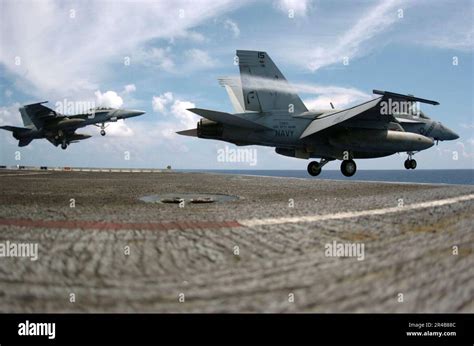
U.S. Navy F/A-18E/F Super Hornet fighter jets launched a record number of sorties against ISIS targets in Iraq and Syria from the USS Dwight D. Eisenhower (CVN-69) in late April, marking the highest number of airstrikes conducted from a single aircraft carrier in support of Operation Inherent Resolve since 2017.
The strikes, carried out over a 72-hour period, represent a significant escalation in the ongoing effort to degrade and ultimately defeat the remnants of ISIS in the region. While the exact number of sorties remains classified for operational security reasons, defense officials confirmed the unprecedented scale of the operation. The USS Dwight D. Eisenhower Carrier Strike Group (IKE CSG), operating in the U.S. Central Command area of responsibility, demonstrated its capability to deliver concentrated and sustained airpower against a determined adversary.
The Navy emphasized that the surge in airstrikes was the result of meticulous planning and coordination between the IKE CSG, Combined Joint Task Force-Operation Inherent Resolve (CJTF-OIR), and other allied partners. The increased tempo also highlights the continued need for a strong U.S. military presence in the Middle East to address persistent security challenges.
“This surge sends a clear message to ISIS and other malign actors that the United States and its allies remain committed to ensuring their lasting defeat,” stated a spokesperson for the U.S. Naval Forces Central Command.
Record-Breaking Sortie Numbers and Operational Context
The previous record for airstrikes launched from a carrier in support of Operation Inherent Resolve was set in 2017 during the height of the campaign against ISIS. The recent surge surpasses that number, underscoring the evolving nature of the threat and the need for a flexible and responsive military posture. While ISIS has been territorially defeated, its remnants continue to operate in Iraq and Syria, carrying out attacks and attempting to regroup.
The F/A-18E/F Super Hornet, a versatile and capable multirole fighter, played a crucial role in the airstrikes. Equipped with a range of precision-guided munitions, the Super Hornets were able to effectively target ISIS positions, infrastructure, and personnel. The aircraft’s advanced sensors and targeting systems allowed pilots to identify and engage targets with minimal risk of collateral damage.
The USS Dwight D. Eisenhower, a Nimitz-class nuclear-powered aircraft carrier, serves as a mobile and self-sufficient base of operations for the Navy’s air wing. With a crew of over 5,000 sailors and a complement of more than 60 aircraft, the IKE CSG is a formidable force capable of projecting power across vast distances.
The carrier’s air wing includes F/A-18E/F Super Hornets, EA-18G Growler electronic warfare aircraft, E-2D Advanced Hawkeye airborne early warning and control aircraft, MH-60R/S Seahawk helicopters, and other support aircraft. This diverse mix of platforms provides the IKE CSG with a wide range of capabilities, including air superiority, strike warfare, electronic warfare, and maritime surveillance.
Operation Inherent Resolve and the Fight Against ISIS
Operation Inherent Resolve (OIR) is the U.S. military’s operational name for the intervention against ISIS. Launched in 2014, OIR aims to degrade and ultimately defeat ISIS in Iraq and Syria. The operation involves a combination of airstrikes, ground operations with partner forces, and support for humanitarian assistance.
The U.S. military works closely with local partners, including the Iraqi Security Forces (ISF) and the Syrian Democratic Forces (SDF), to combat ISIS. These partner forces have played a crucial role in liberating territory from ISIS control and maintaining security in liberated areas.
While ISIS has lost its territorial caliphate, the group continues to pose a threat through insurgent attacks and its global network of affiliates. The U.S. military remains committed to working with its partners to counter ISIS and prevent its resurgence.
Implications of the Airstrike Surge
The recent surge in airstrikes from the USS Dwight D. Eisenhower has several important implications:
- Demonstration of U.S. Resolve: The increased tempo of operations sends a clear message that the U.S. remains committed to the fight against ISIS and is willing to use its military power to achieve its objectives.
- Pressure on ISIS Remnants: The airstrikes put pressure on ISIS remnants in Iraq and Syria, disrupting their operations and limiting their ability to plan and execute attacks.
- Strengthening Partner Forces: By providing air support to partner forces on the ground, the U.S. military helps to strengthen their capabilities and maintain security in liberated areas.
- Regional Stability: The ongoing fight against ISIS contributes to regional stability by preventing the group from regaining territory and destabilizing neighboring countries.
- Strategic Signaling: The deployment and operation of a carrier strike group in the Middle East serves as a signal to other actors in the region, demonstrating U.S. commitment to its allies and deterring potential adversaries.
Future of the Mission
The future of the mission against ISIS remains uncertain. While the group has been significantly weakened, it continues to pose a threat. The U.S. military is likely to maintain a presence in Iraq and Syria for the foreseeable future to continue working with partner forces and counter ISIS remnants.
The specific nature of the U.S. military’s role may evolve over time, depending on the changing security situation and the capabilities of local partner forces. However, the U.S. remains committed to ensuring the lasting defeat of ISIS and preventing its resurgence.
The deployment of advanced platforms like the F/A-18E/F Super Hornet and the EA-18G Growler highlights the technological edge the U.S. military brings to the fight. These aircraft, combined with the command and control capabilities of the E-2D Advanced Hawkeye, provide a significant advantage over ISIS.
Furthermore, the logistical challenges of sustaining a carrier strike group operating thousands of miles from home are considerable. The Navy’s ability to maintain a high operational tempo demonstrates its logistical prowess and its commitment to supporting the mission.
The operation also underscores the importance of international cooperation in the fight against ISIS. The U.S. military works closely with a coalition of allies to conduct airstrikes, train partner forces, and provide humanitarian assistance. This international cooperation is essential to achieving the lasting defeat of ISIS.
Analysis of the F/A-18E/F Super Hornet’s Role
The F/A-18E/F Super Hornet is the backbone of the U.S. Navy’s carrier air wing. It’s a versatile platform capable of performing a wide range of missions, including air-to-air combat, air-to-ground attack, and reconnaissance. The Super Hornet’s advanced sensors, weapons, and electronic warfare capabilities make it a formidable adversary.
In Operation Inherent Resolve, the Super Hornet has been used primarily for air-to-ground attack, providing close air support to partner forces on the ground and striking ISIS targets. The aircraft’s precision-guided munitions allow pilots to engage targets with minimal risk of collateral damage, which is crucial in densely populated areas.
The Super Hornet is also equipped with an advanced electronic warfare suite that allows it to jam enemy radars and communications. This capability is essential for suppressing enemy air defenses and protecting other aircraft.
The F/A-18E/F Super Hornet is constantly being upgraded with new technologies to maintain its edge over potential adversaries. These upgrades include improved sensors, weapons, and electronic warfare capabilities. The Super Hornet is expected to remain in service with the U.S. Navy for many years to come.
The aircraft’s reliability and maintainability are also key factors in its success. The Super Hornet is designed to be easy to maintain, which allows it to operate at a high tempo for extended periods. This is essential for supporting operations like Operation Inherent Resolve, which require a sustained commitment of airpower.
The Strategic Importance of Aircraft Carriers
Aircraft carriers are a vital component of U.S. military power. They provide a mobile and self-sufficient base of operations for naval aviation, allowing the U.S. to project power around the world. Aircraft carriers can be deployed to any region of the world in a matter of days, providing a rapid response capability to crises and contingencies.
The USS Dwight D. Eisenhower is one of the U.S. Navy’s ten Nimitz-class aircraft carriers. These carriers are the largest warships in the world, and they are capable of carrying over 60 aircraft. The Nimitz-class carriers are nuclear-powered, which gives them virtually unlimited range and endurance.
Aircraft carriers are also a symbol of U.S. power and influence. Their presence in a region can deter potential adversaries and reassure allies. The deployment of a carrier strike group sends a clear message that the U.S. is committed to protecting its interests and supporting its allies.
The cost of operating an aircraft carrier is significant, but the capabilities they provide are unmatched. Aircraft carriers are an essential tool for maintaining U.S. security and promoting global stability.
The strategic importance of aircraft carriers is likely to increase in the future as the world becomes more complex and unpredictable. Aircraft carriers provide a flexible and responsive military capability that can be used to address a wide range of threats and challenges.
The Role of Intelligence in the Airstrikes
Effective airstrikes require accurate and timely intelligence. The U.S. military relies on a variety of intelligence sources to identify and track ISIS targets. These sources include human intelligence, signals intelligence, and imagery intelligence.
Human intelligence involves collecting information from people on the ground. This can include information from informants, defectors, and local partners. Signals intelligence involves intercepting and analyzing enemy communications. Imagery intelligence involves analyzing satellite and aerial imagery.
The intelligence collected from these sources is used to create a detailed picture of the enemy’s capabilities and intentions. This information is then used to plan and execute airstrikes.
The U.S. military also uses advanced technologies to analyze intelligence data. These technologies include artificial intelligence and machine learning. These technologies can help analysts identify patterns and trends that would be difficult to detect manually.
The accuracy of intelligence is crucial for minimizing collateral damage. The U.S. military takes great care to ensure that airstrikes are targeted at legitimate military targets and that civilians are not harmed.
The Impact on Civilians
The U.S. military is committed to minimizing the impact of its operations on civilians. However, it is impossible to eliminate the risk of civilian casualties entirely.
The U.S. military takes a number of steps to protect civilians, including:
- Conducting thorough target analysis to ensure that airstrikes are targeted at legitimate military targets.
- Using precision-guided munitions to minimize the risk of collateral damage.
- Providing warnings to civilians before conducting airstrikes.
- Investigating all reports of civilian casualties.
The U.S. military also works with local partners to provide humanitarian assistance to civilians affected by the conflict. This assistance includes food, water, shelter, and medical care.
The U.S. military recognizes that protecting civilians is essential for maintaining the support of the local population and achieving its long-term objectives.
The Long-Term Strategy for Countering ISIS
The long-term strategy for countering ISIS involves a combination of military, political, and economic efforts. The military component of the strategy involves continuing to work with partner forces to degrade and ultimately defeat ISIS remnants. The political component of the strategy involves promoting good governance and resolving underlying conflicts that contribute to the rise of extremism. The economic component of the strategy involves promoting economic development and creating opportunities for people to improve their lives.
The U.S. military is committed to working with its partners to implement this long-term strategy and ensure the lasting defeat of ISIS. This includes building the capacity of local security forces to maintain security in liberated areas and prevent the resurgence of ISIS.
The U.S. also supports efforts to counter ISIS propaganda and online recruitment. This includes working with social media companies to remove ISIS content from their platforms and promoting alternative narratives that counter ISIS ideology.
The long-term strategy for countering ISIS requires a sustained commitment from the U.S. and its partners. However, the U.S. remains committed to ensuring the lasting defeat of ISIS and preventing its resurgence.
The Future of Naval Aviation
Naval aviation is constantly evolving to meet the changing needs of the U.S. military. The Navy is investing in new technologies, such as unmanned aircraft and advanced sensors, to enhance its capabilities.
The Navy is also developing new tactics and strategies for using its aircraft. This includes using unmanned aircraft to conduct reconnaissance and surveillance missions and using advanced sensors to improve targeting accuracy.
The future of naval aviation is likely to be characterized by increased automation and autonomy. Unmanned aircraft will play an increasingly important role in naval operations, freeing up manned aircraft for more complex missions.
The Navy is also working to improve the interoperability of its aircraft with other platforms, such as ships and submarines. This will allow the Navy to operate more effectively in a networked environment.
Naval aviation will continue to be a vital component of U.S. military power in the future. The Navy is committed to investing in the technologies and capabilities that will ensure that it remains the world’s preeminent naval force.
FAQ Regarding the Record-Breaking Airstrikes
1. What triggered this record-breaking surge in airstrikes against ISIS?
The surge was a result of meticulous planning and coordination between the IKE CSG, CJTF-OIR, and allied partners. It indicates a heightened operational tempo to degrade ISIS remnants in Iraq and Syria, responding to intelligence assessments and operational needs on the ground. The increase reflects an adaptation to the evolving tactics and persistent presence of ISIS elements requiring sustained and concentrated aerial support.
2. Why was the USS Dwight D. Eisenhower (IKE) chosen for this specific operation?
The USS Dwight D. Eisenhower (CVN-69), a Nimitz-class nuclear-powered aircraft carrier, provides a mobile and self-sufficient platform with substantial airpower projection capabilities. Its air wing, comprising F/A-18E/F Super Hornets, EA-18G Growlers, and other specialized aircraft, offers a diverse range of offensive and support options. The IKE CSG’s strategic deployment in the U.S. Central Command area of responsibility positions it optimally to respond to regional threats and support Operation Inherent Resolve. Furthermore, its recent operational readiness and strategic positioning made it ideal for executing this surge in airstrikes.
3. What specific targets were struck during these record-breaking airstrikes?
While specific target details are classified for operational security, the targets likely included ISIS positions, infrastructure, and personnel within Iraq and Syria. The aim was to disrupt ISIS operations, degrade their capabilities, and limit their ability to conduct attacks or regroup. Given the precision capabilities of the F/A-18E/F Super Hornets, the strikes likely focused on targets that minimized collateral damage.
4. How does this surge in airstrikes compare to the overall strategy against ISIS? Is it a short-term tactical adjustment or part of a broader strategic shift?
The surge in airstrikes represents a tactical intensification within the broader Operation Inherent Resolve. While not necessarily indicating a fundamental strategic shift, it highlights the adaptability of the U.S. military’s approach to countering ISIS. It suggests a continued commitment to actively suppressing ISIS remnants while longer-term strategies focus on supporting local partner forces and preventing the group’s resurgence. The surge is more likely a calibrated response to immediate operational demands than a complete overhaul of the overarching counter-ISIS strategy.
5. What are the long-term implications of these increased airstrikes for the region’s stability and the future of ISIS?
The long-term implications are multifaceted. While the airstrikes directly degrade ISIS’s immediate capabilities, their effectiveness in achieving lasting stability depends on complementary efforts, including political reconciliation, economic development, and the strengthening of local security forces. The increased airstrikes might temporarily suppress ISIS activity, but without addressing underlying socio-political grievances, the group could potentially adapt and resurge in different forms. Regionally, the operation could also influence the dynamics between various actors and necessitate ongoing diplomatic engagement to manage potential tensions.
6. How does the involvement of allied partners factor into the planning and execution of these airstrikes?
Allied partners play a crucial role within Combined Joint Task Force-Operation Inherent Resolve (CJTF-OIR). Their involvement spans intelligence sharing, logistical support, and, in some cases, participation in airstrikes. The U.S. military coordinates closely with these partners to ensure operational effectiveness and to maintain a unified front against ISIS. This collaborative approach enhances the legitimacy and sustainability of the counter-ISIS mission.
7. What types of munitions were primarily used by the F/A-18E/F Super Hornets during these airstrikes?
The F/A-18E/F Super Hornets likely employed a variety of precision-guided munitions, including Joint Direct Attack Munitions (JDAMs) and laser-guided bombs. These weapons systems allow for accurate targeting, minimizing collateral damage and maximizing the effectiveness of each strike. The specific choice of munitions would depend on the target type and the desired level of destruction.
8. How does the EA-18G Growler contribute to the success of these airstrikes?
The EA-18G Growler, an electronic warfare aircraft, plays a critical role in suppressing enemy air defenses and disrupting ISIS communications. It provides electronic jamming capabilities that protect the strike packages from radar-guided threats and prevent ISIS from coordinating their activities effectively. This electronic warfare support is essential for ensuring the safety and success of the F/A-18E/F Super Hornet airstrikes.
9. What measures are in place to mitigate the risk of civilian casualties during these airstrikes?
The U.S. military employs several measures to mitigate the risk of civilian casualties. These include rigorous target vetting processes, the use of precision-guided munitions, and adherence to strict rules of engagement. Intelligence analysts assess potential collateral damage risks before each strike, and pilots are trained to abort missions if civilians are identified in the target area. Post-strike assessments are also conducted to investigate any reports of civilian casualties.
10. How is the U.S. military adapting its tactics to counter the evolving tactics of ISIS remnants?
The U.S. military is constantly adapting its tactics to counter the evolving tactics of ISIS remnants. This includes using advanced intelligence-gathering techniques to track ISIS movements and identify new threats. The military is also working with local partner forces to improve their capabilities and resilience. The shift from large-scale territorial control to insurgent-style tactics by ISIS necessitates a more agile and intelligence-driven approach to counterterrorism operations. This also includes focusing on disrupting ISIS financing and recruitment networks.









